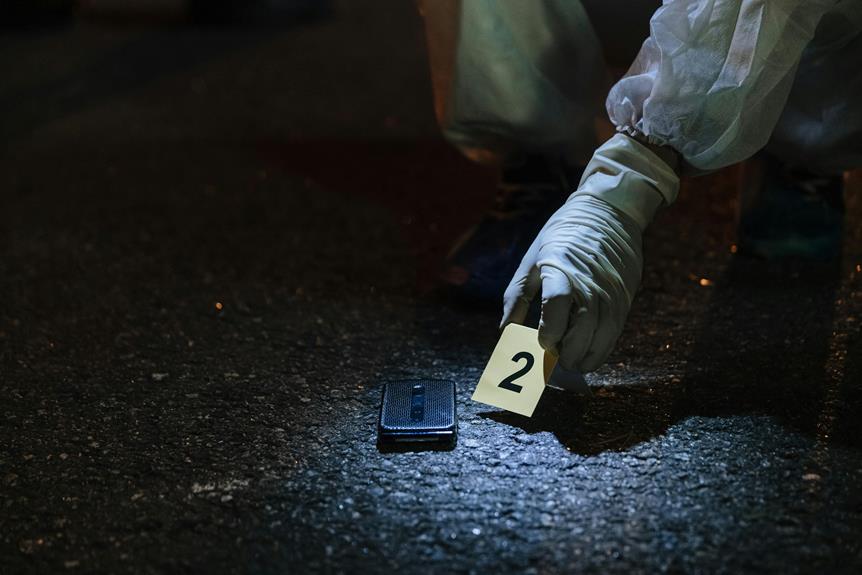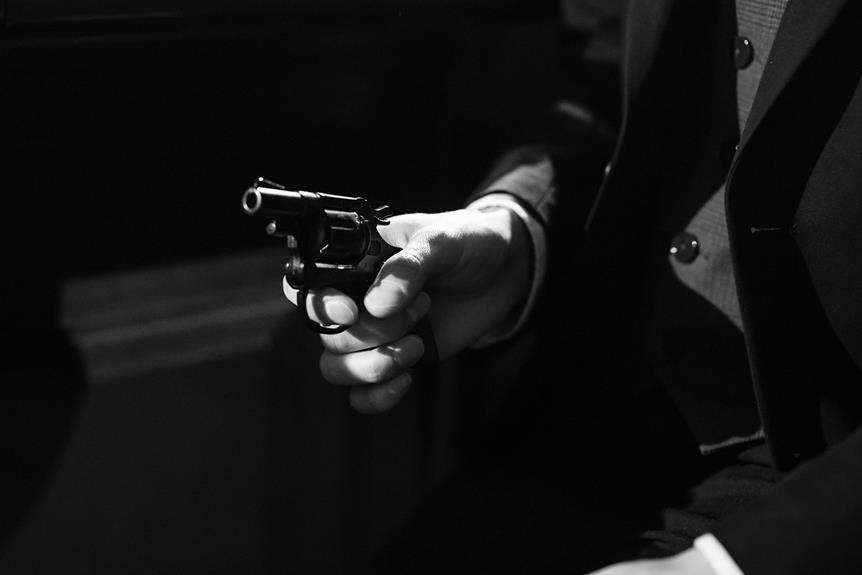The eerie silence of the secluded locations where the Zodiac Killer struck in the late 1960s still holds echoes of the unsolved mystery. From the chilling Lake Herman Road Murders to the brazen attack at Blue Rock Springs, the haunting trail of the killer weaves through various cities in California. With each crime scene meticulously chosen, the question lingers: what drove the killer to select these specific locations and leave behind a trail of cryptic clues? As we explore these chilling sites, a deeper understanding of the enigmatic figure known as the Zodiac Killer begins to emerge, painting a picture of a mind shrouded in darkness.
Key Takeaways
- Zodiac Killer targeted locations in Vallejo, Napa County, San Francisco, and Modesto, California.
- The crimes occurred at Lake Herman Road, Blue Rock Springs, Lake Berryessa, and San Francisco Taxi Driver Slaying.
- The killer demonstrated high premeditation and control in the Lake Berryessa stabbing.
- Kathleen Johns abduction in Modesto remains unsolved despite detailed information and sketch.
- Cryptic messages left by the Zodiac Killer added to the mystique of the case.
Lake Herman Road Murders
The Lake Herman Road Murders, attributed to the infamous Zodiac Killer, took place in Vallejo, California, in December 1968. The incident marked the beginning of a series of killings that struck fear into the hearts of Californians during the late 1960s and early 1970s. The Zodiac Killer, known for taunting the police and media with cryptic messages, was a serial killer whose true identity remains an unsolved mystery to this day.
In the case of the Lake Herman Road Murders, the Zodiac Killer's modus operandi involved targeting young couples in secluded areas. The first victims, high school students Betty Lou Jensen and David Faraday, were shot while parked at a lover's lane on Lake Herman Road. The brutality and randomness of the attack added to the terror gripping the community.
Law enforcement agencies worked tirelessly to solve the case, but the Zodiac Killer's ability to evade capture and his cryptic messages left investigators baffled. Despite numerous theories and suspects over the years, the identity of the Zodiac Killer remains one of the most enduring unsolved mysteries in the history of American crime.
The Lake Herman Road Murders serve as a chilling reminder of the enigmatic nature of serial killers and the challenges authorities face in bringing them to justice.
Blue Rock Springs Attack
Located in Vallejo, California, the Blue Rock Springs Attack was a significant event linked to the notorious Zodiac Killer's reign of terror during the late 1960s and early 1970s. On July 4, 1969, the killer struck at the Blue Rock Springs Park, where he shot and killed Darlene Ferrin and critically wounded Michael Mageau. This attack marked one of the confirmed incidents where the Zodiac Killer directly communicated with the police and media.
Motive speculation surrounding the Blue Rock Springs Attack has been a subject of ongoing debate among investigators and researchers. Some theories suggest that the killer may have chosen the victims randomly, while others propose a more targeted motive related to personal grievances or a desire for notoriety. The cryptic messages sent by the Zodiac Killer added to the mystery surrounding his motives, making it challenging to definitively determine the reasons behind his actions.
Forensic evidence gathered from the crime scene at Blue Rock Springs provided significant insights into the killer's modus operandi. Ballistics analysis and other forensic techniques helped link the Blue Rock Springs Attack to other crimes attributed to the Zodiac Killer, shaping the investigation into his identity. The meticulous examination of forensic clues left behind by the killer remains instrumental in ongoing efforts to solve the case and bring closure to the victims' families.
Lake Berryessa Stabbing
At Lake Berryessa in Napa County, California, a brutal stabbing incident occurred that has been attributed to the infamous Zodiac Killer. The crime scene analysis revealed a meticulously planned attack on the young couple, Bryan Hartnell and Cecelia Shepard, who were enjoying a picnic by the lake on September 27, 1969. Evidence collection at the scene included bloody clothing and a knife believed to be the murder weapon.
The Zodiac Killer's actions at Lake Berryessa provide insight into the psychological profile and motivations of the suspect. The choice of a remote location, the use of disguises, and the elaborate staging of the crime indicate a high level of premeditation and a desire for control. The Zodiac Killer's taunting letters to the police and the media following the attack suggest a need for attention and a desire to instill fear in the public.
The brutality of the Lake Berryessa stabbing, coupled with the Zodiac Killer's cryptic messages and continued elusiveness, have contributed to the enduring mystery surrounding the case. Despite decades of investigation, the true identity of the Zodiac Killer remains unknown, leaving a legacy of fear and fascination in the annals of American crime history.
San Francisco Taxi Driver Slaying
In the city of San Francisco, a harrowing incident involving the fatal assault of a taxi driver has been linked to the notorious Zodiac Killer. This unsolved mystery has long troubled investigators and the public alike, adding another chilling layer to the enigmatic persona of this elusive serial killer.
The incident took place on October 11, 1969, when a taxi driver named Paul Stine was shot to death by an unknown assailant. The killer, believed to be the Zodiac Killer, hailed Stine's cab in the Presidio Heights neighborhood. After a short drive, Stine was shot in the head multiple times, and the perpetrator took off with a piece of the victim's blood-stained shirt as a macabre trophy. This brazen attack sent shockwaves through San Francisco, leaving residents in fear and authorities scrambling for clues.
The connection between the Zodiac Killer and the San Francisco taxi driver slaying remains a subject of intense speculation and investigation. The killer's taunting letters to the press, cryptic ciphers, and erratic behavior have only added to the mystique surrounding this case. Despite decades of scrutiny and numerous suspects, the identity of the perpetrator behind this heinous act continues to elude law enforcement, cementing this tragic event as a haunting chapter in the annals of true crime history.
Paul Stine Murder
The murder of Paul Stine, a taxi driver in San Francisco, on October 11, 1969, stands as a pivotal event attributed to the notorious Zodiac Killer. Stine picked up his passenger in the Presidio Heights neighborhood, and shortly after, he was shot in the head by the passenger, who then took off with a piece of Stine's blood-stained shirt as a trophy. This brazen act marked a shift in the Zodiac Killer's modus operandi, as it was the first killing where a witness survived to provide a description of the suspect.
Below is a table summarizing key information related to the Paul Stine Murder:
| Suspect Descriptions | Evidence | Investigation Updates | Theories |
|---|---|---|---|
| White male, 25-30 years old, crew cut hairstyle | Stine's blood-stained shirt found with the suspect | Handwriting analysis of letters sent by the Zodiac Killer | Theories linking the Zodiac Killer to other unsolved cases |
The investigation into the Paul Stine murder has been ongoing, with law enforcement agencies collaborating to solve the case. Various theories have emerged, including the possibility of the Zodiac Killer being a former or current military personnel due to the precision of the attacks. The case continues to intrigue both law enforcement professionals and amateur sleuths, keeping the mystery of the Zodiac Killer alive.
Presidio Heights Shooting
During the pivotal events of the Presidio Heights Shooting related to the Zodiac Killer, a significant incident unfolded that added a new layer of complexity to the ongoing investigation. The Presidio Heights Shooting took place on October 11, 1969, when a young cab driver, Paul Stine, was fatally shot by the Zodiac Killer. This event marked a departure from the killer's previous crimes, as it occurred in a more affluent neighborhood, raising concerns and intensifying the fear among the public.
In the wake of the Presidio Heights Shooting, investigators delved deeper into analyzing suspect profiles and refining their investigation techniques. The Zodiac Killer's ability to evade capture and leave cryptic messages taunted law enforcement, leading to a meticulous examination of potential suspects. Despite numerous tips and leads, the killer remained elusive, showcasing a level of cunning and premeditation that challenged the authorities.
The Presidio Heights Shooting underscored the Zodiac Killer's audacity and strategic approach to his crimes. The meticulous planning and execution of the attack hinted at a methodical mind, leaving investigators grappling with the complexity of the case. The use of forensic evidence and behavioral analysis became essential in attempting to decipher the motivations and identity of the elusive killer. The Presidio Heights Shooting remains a pivotal moment in the Zodiac Killer's reign of terror, leaving a lasting impact on both the investigation and the public's psyche.
Kathleen Johns Abduction
With the abduction of Kathleen Johns, a pivotal event in the Zodiac Killer's series of crimes unfolded, adding another layer of complexity to the ongoing investigation. Kathleen Johns was driving with her infant daughter on Highway 132 near Modesto on March 22, 1970, when a man in a car signaled that her back wheel was wobbling. After pulling over to check the wheel, the man offered to fix it, but instead, he tampered with her car, leading to it stalling. He then offered to drive her to a gas station, but instead took her on a terrifying journey where she managed to escape with her daughter. Johns reported the incident to the police and provided details that helped create a suspect sketch, but the case remains an unsolved mystery.
Witness testimony from Kathleen Johns revealed chilling details of her encounter with the Zodiac Killer. She described cryptic messages exchanged with the perpetrator during the abduction, adding to the enigma surrounding the identity of the killer. Despite Johns' bravery in escaping and providing valuable information, the Zodiac Killer's true identity and motives remain elusive, leaving law enforcement and armchair detectives puzzled by this disturbing chapter in American criminal history.
Possible Zodiac Crime Scenes
One notable aspect of the Zodiac Killer investigation involves identifying and analyzing potential crime scenes across various locations in the USA. These locations have become the focus of intense scrutiny due to the cryptic messages left by the killer and the unsolved mysteries surrounding the cases.
The first possible Zodiac crime scene is Lake Herman Road in Benicia, California, where the Zodiac Killer struck on December 20, 1968, claiming the lives of Betty Lou Jensen and David Faraday. The killer's cryptic messages taunted investigators and added to the mystique of the case, which remains unsolved to this day.
Another significant location linked to the Zodiac Killer is Blue Rock Springs Park in Vallejo, California. On July 4, 1969, the killer attacked Darlene Ferrin and Michael Mageau, leaving one dead and one injured. The cryptic messages sent to local newspapers following this crime further fueled public fascination with the case and the enigmatic persona of the Zodiac Killer.
The final site worth mentioning is Lake Berryessa in Napa County, California, where the Zodiac Killer attacked Bryan Hartnell and Cecelia Shepard on September 27, 1969. The killer's elaborate costume and cryptic messages carved into the victims' car added layers of complexity to the unsolved mysteries surrounding this brutal crime.
Frequently Asked Questions
What Was the Zodiac Killer's Motive for Targeting Specific Locations?
When examining the motive behind the Zodiac Killer's selection of specific locations, one must consider the patterns and behaviors exhibited by the perpetrator. Geographical profiling can shed light on potential reasons for these choices, such as familiarity with certain areas, access to victims, or the desire to create a specific image or message through the location selection.
Understanding these elements can provide valuable insights into the mindset and motivations of the killer.
Were There Any Witnesses to the Zodiac Killer's Crimes?
In criminal investigations, witness testimonies play a vital role in unraveling the truth behind the events. The credibility of witnesses can greatly impact the outcome of a case, shaping public perception and influencing legal proceedings.
Media sensationalism and coverage often cast a spotlight on witness accounts, scrutinizing their reliability and accuracy. The interplay between witness credibility and media portrayal can either strengthen or weaken the pursuit of justice in high-profile cases.
Did the Zodiac Killer Leave Any Clues at the Crime Scenes?
Possible clues left at crime scenes by the perpetrator are pivotal in criminal investigations. These clues hold significant value in constructing suspect profiles based on modus operandi, behavior patterns, and potential motives.
Analyzing these clues with precision and objectivity is essential to unraveling the mystery behind crimes. By meticulously examining the evidence left behind, investigators can piece together a narrative that sheds light on the identity and motivations of the individual responsible.
How Did Law Enforcement Respond to the Zodiac Killer's Crimes?
Law enforcement tactics in response to the Zodiac Killer's crimes involved extensive investigation techniques. Task forces were formed, focusing on analyzing evidence, creating profiles, and coordinating with various agencies.
Deciphering cryptic messages left by the killer was a priority, alongside tactical surveillance and stakeouts. Authorities employed forensic science advancements to gather and analyze clues meticulously.
The pursuit of the Zodiac Killer exemplified a combination of traditional policing methods and innovative approaches to solving complex cases.
Are There Any Theories About the Zodiac Killer's Whereabouts After the Crimes?
Like shadows in the night, speculation surrounds the Zodiac Killer's post-crime whereabouts. Theories suggest possible hideouts in remote areas or urban anonymity.
Some ponder the existence of potential accomplices aiding in evasion. Despite the passage of time, the mystery endures, captivating those yearning for answers in a tale of enigmatic intrigue.
The search for the truth continues, fueled by curiosity and a quest for closure in the face of elusive secrets.
Conclusion
To sum up, the Zodiac Killer's reign of terror across California left a trail of unsolved mysteries and fear in its wake, much like a shadow looming over the unsuspecting victims.
The meticulously planned attacks and cryptic messages continue to captivate and baffle investigators and true crime enthusiasts alike, making the case of the Zodiac Killer a haunting reminder of the darkness that can lurk in the shadows of society.


